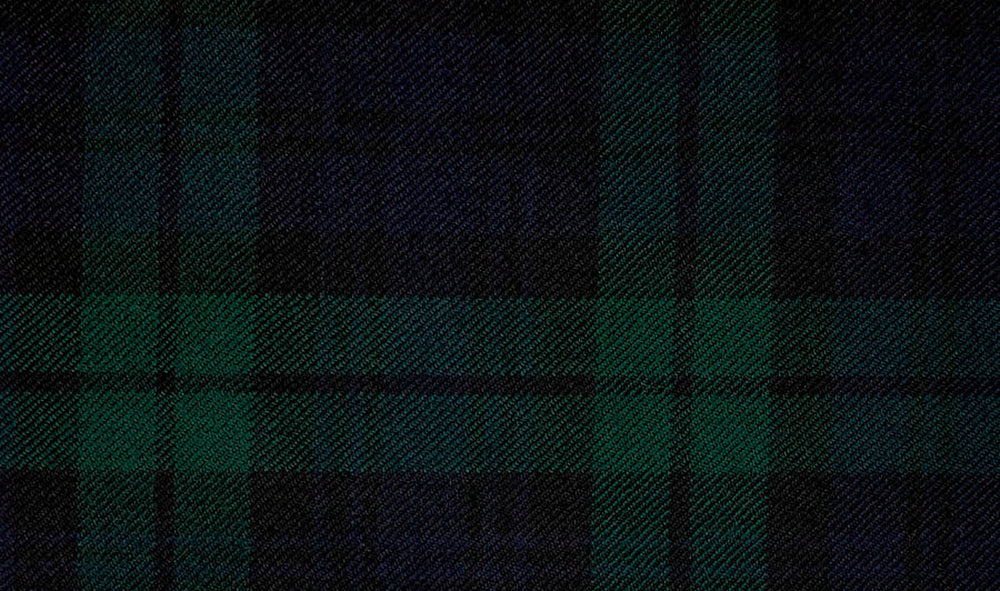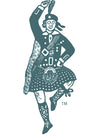Black Watch tartan is one of the most instantly recognised and popular Scottish tartans, with distinctive bands of dark green and navy with black stripes. But what’s so special about this particular tartan?
Black Watch tartan is also known officially as the Government tartan. Its name comes from the ‘Black Watch’ of companies that were put in place by the government in the early 18th century to suppress Scottish rebellion in the Highlands.
Although still strongly associated with the Royal Highland Regiment, Black Watch tartan is an 'open tartan' in that anyone can wear it. It has no affiliation with a specific clan but it does symbolise tradition and bravery.
You’ll see Scots wearing it at Highland Games and weddings. And it is often worn by celebrities – from the super model Iman to Tom Jones and the Duchess of Cambridge. Even Theresa May when she was Prime Minister was often seen in her Vivienne Westwood Black Watch tartan suit.

In this blog post we take a look at the fascinating history of this unique tartan and the role it has played in the history of Scotland itself.
A BRIEF HISTORY OF THE BLACK WATCH

The Black Watch story begins with the Jacobite rising of 1715. This was the attempt by James Edward Stuart to regain the thrones of England, Ireland and Scotland. He was the son of the Catholic King James II and VII who was deposed in 1688 by his daughter Mary and her protestant Dutch husband William III.
Supporters of James were called ‘Jacobites’ and they plotted to overthrow their protestant rulers. Although they weren’t successful, unrest continued. The government made carrying weapons illegal and some clan chiefs loyal to the crown started to form militias to enforce this. By 1725, General George Wade had assembled six ‘watch’ companies to patrol the Highlands.
These independent companies were made up of trustworthy men from the Campbell, Fraser, Grant and Munro Clans. The men were from Perthshire, Fife, Dundee and Angus. They knew the terrain and the communities well.
Their mission was to basically keep the peace and the companies became known as ‘Am Freiceadan Dubh’ – or ‘Black Watch’ – in Scots Gaelic. It’s thought that the name refers to the dark tartan the men wore.
By 1739 four more companies were added to create a single infantry unit known as the Black Watch Regiment. It’s from this point that what we know as the Black Watch tartan became part of the official regimental uniform.
The uniform comprised a scarlet jacket and waistcoat worn with a kilt made from 12 yard lengths of wool plaid. The men would wear some of the plaid loosely gathered around the waist and held in place with a belt. One end of the huge length of plaid was then draped over the left shoulder and pinned in place.
This was highly practical as it could then be used to throw over both shoulders and head when it rained and at night the plaid could be used as a blanket. You can read more about the evolution of the kilt in our blog post The history of tartan.
THE BLACK WATCH TIMELINE
- 1725 Six Independent Companies are assembled by General Wade to keep the peace in the Highlands.
- 1739 The six Independent Companies are amalgamated to form the Black Watch Regiment, which wore the regimental Black Watch tartan that is recognised today.
- 1881 The Black Watch (Royal Highlanders) Regiment is formed by the merger of The 42nd Royal Regiment (which became the 1st Battalion) and The 73rd Royal Regiment (which became the 2nd Battalion).
- 1931 Name changes to The Black Watch (Royal Highland Regiment).
- 2006 The Royal Regiment of Scotland is formed with The Black Watch (Royal Highland Regiment) becoming Black Watch, 3rd Battalion of Royal Regiment of Scotland.
THE BLACK WATCH - A DISTINGUISHED MILITARY HISTORY

Over time, the Black Watch became more of a fighting force in the British army and over the past 200 years, has fought in all of the British Army’s campaigns. And just as the regiment itself has evolved, so has its uniform.
Kilts became shorter and more manageable but were worn as part of the regiment’s everyday uniform until 1940. Today a classic short worsted wool kilt in Black Watch tartan is worn for regimental dress purposes only.
The Black Watch has a long and distinguished military history, with more than 100 battle honours. It has seen active duty all over the world. It fought in the French and Indian wars in North America, and then in the Napoleonic wars in Europe.
The regiment was also active in the Crimean War, the Boer War and in both World Wars. More recently, the Black Watch has seen active duty in Iraq and Afghanistan. If you’re visiting Perth in Scotland then you should add a trip to the Black Watch Museum to find out more.
BLACK WATCH FUN FACTS
- In the First World War, German soldiers apparently called The Black watch ‘ladies from hell’ because of their ferocity and the fact they wore kilts.
- Laurel & Hardy performed a dance in the film Bonnie Scotland wearing Black Watch kilts.
- In 1963, bagpipers from the Black watch regimental band played in the state funeral procession for John F Kennedy in Washington DC.
- The Black Watch was the last British military unit to leave Hong Kong in 1997 when it was handed back to China.
WHY IS BLACK WATCH SO POPULAR?

The sustained popularity of Black Watch tartan can be largely explained by the fact that it is a ‘universal’ or ‘open’ tartan that has no clan affiliation – so anyone can wear it. Black Watch tartan is also strongly associated with Scottish history and tradition with its links to the Black Watch regiment.
Another key reason people like it so much is down to its subtle dark colours. This means it works well in many colours and fabrics, from wool and tweed to silk. And this makes it a popular choice for both men’s and women’s wear. It also works well for accessories such as scarves, gloves and bags as it is not an overpowering tartan.
Interior designers love Black Watch tartan too and you’ll find it used on everything from wallpaper to curtains, carpets and bedding.
HIGHLAND STORE TARTAN
As a store that specialises in Scottish clothing and accessories, it won’t come as a surprise that we love Black Watch tartan and it often features in our women’s and men’s ranges.
For instance, for men we stock Black Watch tartan kilts as well as wool ties. We also have women’s kilts in Black Watch tartan as well as a soft Lambswool Tartan Shawl and a luxurious cashmere scarf.
Black Watch tartan also works really well in Harris Tweed® and we stock superb tweed and leather gloves for men and women, as well as a Handmade Beret Tam. Our women’s bag collection also features everything from handy tote bags to shoppers, handbags and satchels made with Harris Tweed® in Black Watch tartan.



